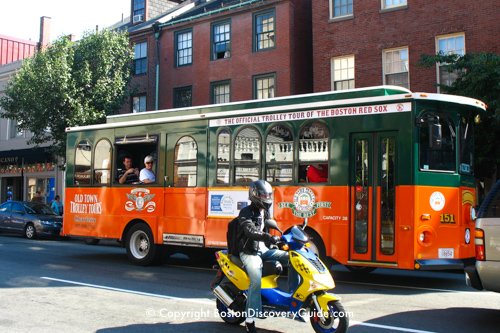The bloodiest and most deadly battle on Day 1 of the Revolutionary War raged not in Lexington, where the first shots rang out, or Concord, where the British Redcoats hoped to "liberate" a stockpile of munitions, but in the small farming village of Menotomy.
At around 3am on April 19th, the British passed through Menotomy (now named Arlington) without incident on their way to Concord. With only about 400 residents, one meeting house, several taverns and a few mills, Menotomy offered little to catch anyone's attention.
After failing to find munitions in Concord, the British begin their march back to Boston, reinforced by additional troops sent to rescue them - but news about the deaths at Lexington and Concord has been spreading for hours across the countryside, stoking plenty of anger along the way, and more than 1,000 Colonial militia and minutemen ambush them at multiple points along the way.
Around 4pm, the fleeing Redcoats reach the beginning of the Foot of the Rocks in what is now Arlington Heights. As they attempt to continue east toward Cambridge, a running battle unfolds along a mile-long section of the unpaved road (now Massachusetts Avenue) in a running battle.
Pursued by infuriated Colonials from Concord and fearing more attacks from snipers, the 1,800 or so Redcoats start preemptively burning everything in their path as they advance.
Their fear is justified. Hidden behind rock walls and in deserted houses and barns, as many as 3,800 members of 59 Colonial militias from as far away as Salem, Danvers, and Dedham await them, armed and angry.
Brutal fighting, looting, and burning ensue during an almost 4-hour battle believed to have involved around 6,000 people, including British troops, Colonial militias, pursuers from Concord, and older men, women, and children from Menotomy who defend their homes and their town.
Today, you can still see numerous bullet holes at Jason Russell house, where the British shot and bayoneted the owner on his doorstep along with 11 others.
When the battle finally ended as the Redcoats fled back to Boston, 40 British troops and 25 Colonials were dead.
Although survivors of the battle at Menotomy later described many acts of bravery, one fighter in particular stands out: Samuel Whittemore, who demonstrated that heroism knows no age limits.
Top photo: Patriots Day reenactors portraying the Menotomy Minute Men
Boston Discovery Guide is a reader-supported publication. When you buy through our links, we may earn a commission at no additional cost for you. Learn more
Who was Samuel Whittemore? And How Did He Get to Menotomy?
Born in England in 1694, Samuel Whittemore joined the military and rose to the rank of Captain in the British Army.
After moving to the Colonies at age 51 to fight against the French in 1745, Whittemore bought a farm in Menotomy, no doubt looking forward to a peaceful life. He married, helped raise his eight children, and became active in town government.
When war broke out again between the British and the French in 1758, Whittemore fought again on the side of the British.
And still later in 1763, he left his wife, children, and grandchildren to tend to the Menotomy farm while he fought again - but this time, as part of a Colonial regiment in the Indian Wars. In case you're doing the math, you're right - he's now 69 years old.
So in another dozen years when the American revolution against the British begins when he's 81, surely he's done enough?
Not by a long shot.
Revolution Reaches Menotomy: Is Sam Too Old to Fight?
March Events
Tension between the Colonies and England had been brewing for decades.
By the 1760s, Massachusetts Bay Colony buzzed with talk about resistance.
And in Boston, Sam Adams and other agitators inflamed patriotic feelings with their talk about revolution.
Records from the late 1700s state that Sam Whittemore supported independence from the British.
Why?
Well, the reason was pretty simple. He wanted his children, grandchildren, and future descendants to have a voice in making their own laws, free from the whims of a distant king.
So when he sees the first group of 700 Redcoats march through Menotomy on a cold April morning in 1775 and hears rumors about battles in Concord and Lexington, he suspects trouble.
And then, as he watches an additional 1,100 reinforcements march in that direction and then turn back, he knows the situation is serious.
Even though he is, yes, now almost 81, he straps on a sword, sticks a couple of pistols inside his belt, grabs his musket and some powder, and crouches behind a stone wall on what today is Mystic Street, near the corner of Chestnut Street.
From here, Sam has an excellent view of the Lexington Road. (Which was what we now call Massachusetts Avenue.)
Other Menotomy Minute Men plead with him to move to a safer spot, but Sam says, “If I can only be the instrument of killing one of my country's foes, I shall die in peace.”
The Menotomy Ambush Turns Lethal
When the British draw near, the Menotomy Minute Men start firing and then step back out of range to reload their weapons.
Sam waits in his ambush position until the Redcoats are almost right in front of him.
At the last possible second, he leaps out. First he fires his musket and then his pistols at almost point-blank range, killing two and mortally wounding another.
Then a British soldier fires a musket at his head, also point-blank. The musket ball tears through his cheek, rips off half his face and causes him to fall to the ground.
When Sam tries to rise, fending off the British bayonets with his sword, another soldier strikes him on the head with a musket butt while others bayonet him 13 times, exclaiming “We have killed the old rebel!” (Those are not the exact words they used, but they're the family-friendly version.)
The British troops continue fighting their way through the streets of Menotomy.
When they finally break free from the enraged Colonists and continue their running retreat to Boston, the toll is 40 British dead and 80 wounded - the highest casualties on that first day of the American Revolution.
(In case you're wondering, people wrote lots of letters, kept detailed diaries, and gave detailed depositions to the Massachusetts Bay provincial legislature, which is why we know so much today about what people actually said and did.)
Tours through Boston's History
Menotomy Counts Its Dead and Wounded
About four hours later after the last British troops finally disappear in the distance, the Menotomy town people and Minute Men come out collect their wounded and dead.
They fully expect to find Sam Whittemore's body since a number of them witnessed his fight and saw him fall.
So you can imagine their shock when they discover he's still alive - and in the process of reloading his musket, hoping to get one last shot at the retreating Redcoats.
Using a door as a make-shift stretcher, they carry him to nearby Cooper Tavern.
Dr. Nathaniel Tufts from Medford cuts away his clothing and examines his extensive and rather horrific wounds. The townspeople recount all of this in quite graphic detail in their letters and journals - but we're giving you just the sanitized summary version in case you're enjoying a snack as you read this.
Certain that Whittemore will die from internal bleeding and injuries, Dr. Tufts remarks that even attempting to dress so many wounds is useless. Only because friends and family insist does he patch Sam up the best he can before sending him home to die.
But... Sam Wasn't Dead Yet
To everyone’s surprise—although perhaps not his own—Samuel Whittemore lives to see the Colonies gain their independence and become the United States of America.
In fact, he recovers and enjoys another active 18+ years of life, proud of his service to his country.
When Sam finally passes at age 99, the cause of his death is simply old age.
And best of all, his 185 children, grandchildren, great grandchildren, and great great grandchildren alive at the time of his death are free Americans - no longer the subjects of a king.

































